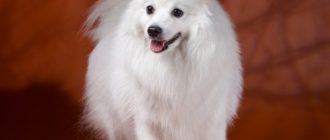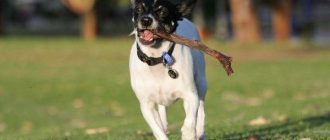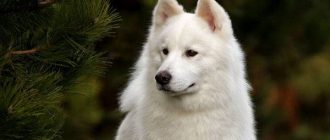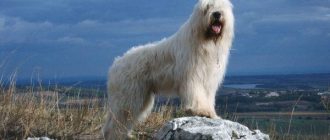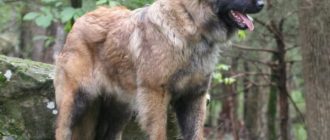Assessment of breed characteristics
Contents
| Adaptability Definition of how easy a dog is. can adapt to changes in life. |  |
| Shedding Level Level and frequency of hair loss in animal. |  |
| Level of tenderness Level and amount of tenderness and affection that the dog gives back in return for attention to itself. |  |
| Need for Exercise Daily Activity Level dogs. |  |
| Social need Required number of dog contacts with other animals as well as people. |  |
| Housing ratio Factor that determines the level of noise and other inconvenience that the dog can deliver to the owners in the ratio apartment size to dog size. |  |
| Grooming Number of bathing, combing, as well as necessary number of professional grooming sessions required the dog. |  |
| Friendliness in an unfamiliar environment society with strangers or in an unfamiliar environment. |  |
| The tendency to bark The tendency to bark and its frequency and volume. |  |
| Health Issues Potential Health Status dogs. |  |
| Territorial tendency of the dog to protect his house, yard or even a car owner. |  |
| Cat friendliness A trend towards cat tolerance and reduced manifestation of hunting instincts. |  |
| Intelligence Dog’s ability to think and solve emerging difficulties (not to be confused with learning!). |  |
| Education and training Level of difficulty in training a dog perform certain actions. |  |
| Friendliness for children Factor determining how much the dog friendly to children, whether she likes to play with them and endure some children’s pranks. |  |
| Game activity The concept is determined by its very name, and, usually found in almost all dogs. |  |
| Observing Dog’s ability to detect presence a stranger in his territory. |  |
| Friendliness for other dogs Dog’s tendency to find common language with other relatives. |  |
Brief description of the breed
Big-eyed decorative dogs with an aristocratic name Cavalier King Charles Spaniel breeds that once made up the company people from high society in the UK, today is great get along in simple families all over the world. These dogs are good-natured, Perfectly establish contact with people and other animals. IN in some cases, cavaliers are taken as assistants by hunters during small game prey, but most often they are home friends, companion dogs. Compact size and light weight these spaniels allow you to keep them on a small living space, which also important (especially for residents of megacities). So, gentleman King Charles Spaniels are small, proportionate dogs whose weight varies between 5 – 8 kg, height – 25-35 cm. Head shape in the ears are flat, the muzzle is small, tapering towards the nose. A distinctive feature of these dogs is large and convex, widely set eyes are round. The ears of the cavaliers are high set, hanging, with long hair. Scissor bite. Dog neck medium in length, does not have a suspension, smoothly passes into the shoulders. The body is stretched, the back is straight, passes into a smoothly beveled croup dogs. The limbs are straight, parallel, the legs are small in size. The tail is set low (sometimes docked). The coat is long, sometimes slightly wavy, especially long on ears, paws, tail, characteristic of the breed. The color of dogs can be 4 colors: ruby (red), blenheim (red marks on a white background of wool, extending not only to the body, but also to the eye area and lower part of the ears with a white bore between the eyes), tricolor (black marks on a white background of wool with a white groove between eyes and tan marks in the eyes, cheekbones, inner sides of the ears, tail, legs) and black and tan (red tan above the eyes, from the inside of the ears, on the throat, chest, on forelimbs from knees to paws, on the hind limbs with inner side to the tips of the paws, below the tail).
Photo cavalier king charles spaniel:


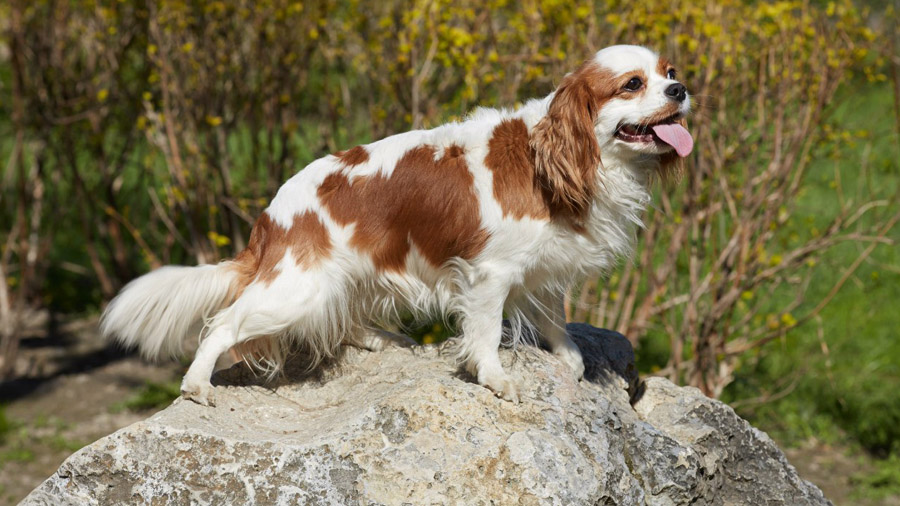


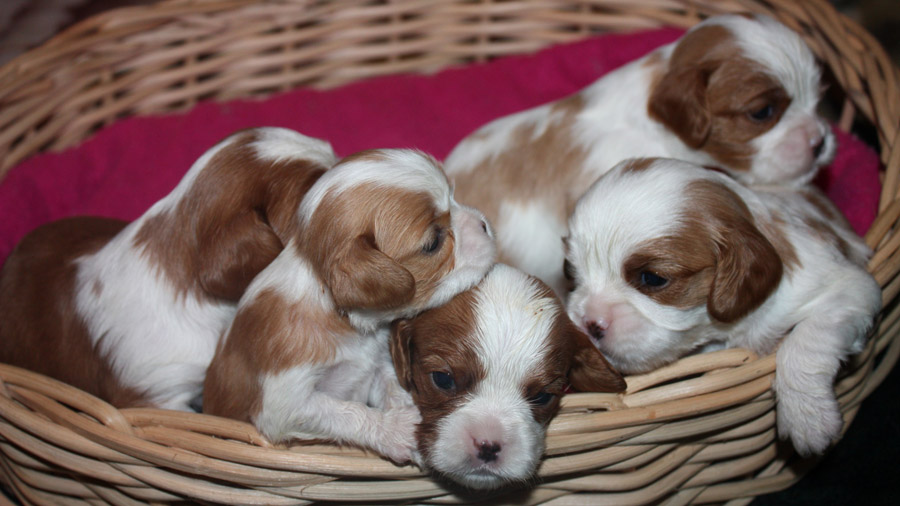 Photo of Cavalier King dogs Charles Spaniel |
Photo of Cavalier King dogs Charles Spaniel |
Origin history
In fact, these dogs have a very rich history, and the breed the cavalier king charles spaniel is inextricably linked with another breed – king charles spaniel. The popularity of toy spaniels in Britain started around the 15th century, and the first mention of similar small dogs accompanying noble and royal people everywhere, appeared in the 13th century. It is not known exactly which breeds dogs were the ancestors of the English toy spaniels, since one at a time versions of these little dogs brought to Britain Celts with Iberian Peninsula in the 9th century, according to another version such dogs (being descendants of the Pekingese) were imported from China into the same a period of time. According to the third version of the toy spaniel were brought from Italy in the 13th century. In the 15-16 century, toy spaniels became so popular in the british isles that even royals don’t shunned to let these dogs into their luxurious lounges. For instance, Spaniels were in the Tudor dynasty – English King Henry VIII, Queen Elizabeth I. Particularly loved steel spaniels during the reign Stuart – King Charles (Charles) I and his son Charles (Charles) II. It is generally accepted that it was in honor of Charles II that she received her breed name (king charles spaniel) as this ruler was so attached to small dogs that they were allowed enter the royal chambers, churches and the British House of Commons. Until the 19th century, the King Charles Spaniels were not only close to court, but also accompanied the monarchs during the audience, festive events. In the second half of the 19th century, the popularity of steel conquer short-haired dogs, during which King Charles began to interbreed with pugs and Chinese hins. Result such kinship has become a significant change in the appearance of king Charles – a short muzzle, a round forehead and ears set low. Former King Charles (so beloved by the English royal dynasties) become a curiosity. And only in the second half of the 1920s, English breeders led by R. Eldridge began to lead a systematic work to preserve the traditional “old” look of king charles – flat-faced and long-faced. The best individuals were selected, which gave new life to the breed, undeservedly forgotten. “New” breed, which, in fact, over the age of centuries superior to the “old”, received name cavalier king charles spaniel (thanks to Charles II and his associates – cavaliers).
Character Cavalier King Charles Spaniel
Cavaliers are smart enough, good-natured, emotional and loyal to the owner of the dog. They are balanced, tolerant of guests at home. An innate sense of friendliness to people will not allow them to become security guards, although they like to bark. Cavaliers certainly need communication and daily tactile contact with the owner. Bored the dog can seriously suffer: get depressed, howl idle, become aggressive. Puppies accustomed to society are playful, obedient, kind to children and animals. Perfectly trained, perceiving the host team as a game. In a word, these dogs are excellent suitable for a family with a relaxed lifestyle. Main need gentlemen – communication with your dear master. These dogs are not trying to take the palm in their paws, so the owner a gentleman may be a gentle person, but not a leader at all strict rules.
Maintenance and care
Cavalier King Charles Spaniels do not tolerate the harsh climate, temperature changes, dampness. Therefore their personal the space should be within the boundaries of the house or apartment. And thanks to them miniatures it’s not difficult to find a convenient corner without drafts, providing it with a stove bench, dishes and toys for games (and, perhaps a tray for the first time when the puppy is not used to kvigulam, making puddles and heaps). These dogs can not be called excessively active, although daily walks they naturally need. At home they behave “culturally”, but with a lack of attention with side of the host and the rare boardwalk are able to do a little dirty work, to for example, nibble shoes or furniture, also these dogs at small mobility quickly gain weight. That’s why it’s worth giving it animals the opportunity to walk on a leash every day at least hours. Thick luxurious hair of gentlemen should be combed out stiff with a brush and slicker every day (or at least a couple of times a week) during avoid the appearance of warlocks. Thick wool between pads fingers can be trimmed gently. Often animals are exposed cutting, shortening the so-called decorating long hair. Can resort to the services of a groomer who will explain exactly how best look after the hair of the gentlemen. Ear Care (long ears with luxurious hair in dogs of this breed need careful care), the teeth and claws of a pet can also be trusted with a specialist or do it yourself. Particular attention should be paid to and to the eyes of these animals, since cavaliers are often found eye inflammation. Dogs are bathed no more than 3 times a year shampoo for long-haired dogs. Cavaliers are unpretentious in food, just pick them a menu that will be rich vitamins and minerals, whether it’s natural food or ready-made industrial feed. The dog should always have a bowl with clean water to drink.
Training and training
Good features of cavaliers in the process of training are obedience and lack of stubbornness characteristic of most breeds. Even inexperienced owners can instill in their dog such a desire Breeds are necessary for a comfortable existence in society. Good attitude, encouragement for a well-executed team, lack of excessive loads – and the dog will become obedient, not will bring headaches to owners and annoy neighbors. But a sizmala dog should be taught the rules of good behavior, socialization. To do this, stop the puppy’s attempts bite, make puddles in the wrong place, overly annoy your society to all family members, get into bed, beg for goodies from the table and stuff. And also the puppy must be accustomed to noise cities, other animals, small children, should not be afraid of everything or be overly curious about the potentially dangerous subjects. When the baby cavalier adapts enough and gets used to to a new home (and the owner will earn the puppy’s trust), you can go with dog general obedience course (OKP). In the process of OKP animal will receive such skills: endurance, a call to the team “to me”, walking “near”, the execution of the commands “sit”, “lay”, “stand”, “place”, refusal to eat from the ground or from the hands of a stranger by to fu, the dog will be accustomed to a muzzle.
Health and Disease
Cavaliers faithfully serve their master for about 10-12 (rarely 15) years. This breed is considered quite strong in terms of health (if it is is about a dog with documents purchased from a respectable breeder). However, these decorative spaniels may be congenital and acquired diseases most often occurring of which: Legge-Perthes disease (hereditary a disease characteristic of small dogs, which consists in destructive processes of the femoral head), dislocation of the patella (congenital or traumatic nature in which occurs displacement of one bone relative to the articular surface of another), epilepsy (a genetic or acquired disease, neurological impairment of brain function), hernia intervertebral discs (prolapse or protrusion of the intervertebral disc disk into the lumen of the spinal canal), hydrocephalus (large cerebrospinal fluid accumulation in the cerebral ventricles), congenital and acquired eye diseases (increased ocular pressure – glaucoma, inversion of the eyelid, clouding of the lens – cataract), otitis media (ear inflammation), heart failure (congenital, acquired or age-related).

